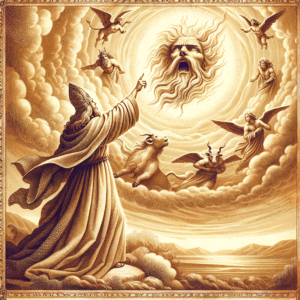
The Bible, revered by billions, is a tapestry of narratives, prophecies, and visions that have shaped spiritual discourse for millennia. Among its rich texts, the books of Ezekiel and Revelation stand out for their vivid imagery and profound messages. Central to these books is the concept of the “Breath of Life,” a divine force that signifies spiritual awakening and renewal. This article delves into how this concept links the prophetic visions of Ezekiel with the apocalyptic revelations of John, highlighting the continuity and depth of biblical prophecy.
Exploring the Breath of Life in Biblical Prophecy
In biblical literature, the “Breath of Life” is pivotal, signifying God’s life-giving power. It first appears in Genesis when God breathes life into Adam, transforming clay into a living soul. This theme recurs throughout scripture, symbolizing divine intervention and spiritual renewal. The “Breath of Life” is not just a physical act but represents a spiritual rejuvenation, a rekindling of faith and purpose. In the context of prophecy, it often heralds a new era or a significant transformation, underscoring God’s omnipotent role in guiding humanity.
Ezekiel’s prophecy, documented in the Old Testament, is one of the most compelling illustrations of the “Breath of Life.” In Ezekiel 37, the prophet envisions a valley filled with dry bones, representing the fractured spirit of the Israelites. God commands Ezekiel to prophesy over the bones, promising to infuse them with breath and restore them to life. This vision encapsulates hope and renewal, with the “Breath of Life” symbolizing the return of the Israelites to their land and the revival of their covenant with God. It exemplifies the transformative power of divine breath, turning desolation into vitality.
The Book of Revelation, penned by John the Apostle, revisits this concept, albeit with apocalyptic grandeur. Revelation’s imagery, rich with symbolism, uses the “Breath of Life” to depict the resurrection of two witnesses, who stand as harbingers of God’s final judgment. Their revival signifies the triumph of faith over persecution and reinforces the message that God’s breath is a source of life even amid impending doom. Thus, within the prophetic framework, the “Breath of Life” serves as a beacon of hope, linking these narratives across time and testament.
Linking Ezekiel’s Vision to Revelation’s Imagery
Ezekiel’s vision of the dry bones is emblematic of spiritual resurrection and renewal. The act of God breathing life into the bones is not merely a miraculous event but a metaphor for Israel’s national and spiritual restoration. It highlights the restoration of hope and the rejuvenation of a covenant people, emphasizing that divine intervention is crucial in overcoming spiritual desolation. The imagery conveys a message that transcends its immediate context, pointing to a broader theme of redemption and divine faithfulness.
Revelation’s imagery echoes this theme but expands it within an eschatological framework. The two witnesses, after fulfilling their prophetic duties, are slain only to be revived by God’s breath, symbolizing the ultimate vindication of the faithful. This resurrection serves as a testament to the enduring power of divine spirit, which transcends death and assures believers of the promise of eternal life. The “Breath of Life,” in Revelation, is a foretaste of the final resurrection, a key component in the narrative of the world’s ultimate renewal and the establishment of God’s kingdom.
The continuity between Ezekiel and Revelation’s use of the “Breath of Life” underscores a profound theological link between the Old and New Testaments. While Ezekiel speaks to a specific historical context, Revelation extrapolates this to a universal scale, offering a prophetic vision of hope and salvation. The thematic resonance between these texts highlights the unchanging nature of God’s promises and the enduring hope offered to believers. The “Breath of Life” serves as a divine affirmation, bridging prophetic visions across time, and providing a cohesive narrative thread within the tapestry of biblical prophecy.
In examining the “Breath of Life” within the visions of Ezekiel and Revelation, we uncover a profound link that underscores the unity and continuity in biblical prophecy. This divine breath symbolizes more than physical life—it represents hope, renewal, and God’s unwavering commitment to His people. Whether reviving a nation from spiritual barrenness or promising an eternal resurrection, the “Breath of Life” stands as a testament to divine power and faithfulness across centuries. These narratives, though separated by time and testament, converge to illuminate a singular truth: the transformative and sustaining power of God’s spirit in the journey of faith.


Comments Feed
This page is used for syndicating comments across the website. If you’re looking for more engaging content, check out our latest articles and insights:
Stay connected with our latest teachings and insights by subscribing to our newsletter:
Subscribe Now